如何在pandas的apply函数中使用参数
参考:pandas apply with arguments
在数据分析过程中,经常会用到Python的pandas库来处理和分析数据。pandas库提供了非常强大的数据处理能力,其中apply函数是一个非常重要的工具,它允许用户对DataFrame或Series中的数据应用一个函数。本文将详细介绍如何在pandas的apply函数中使用参数,包括多个示例代码,帮助读者更好地理解和掌握这一技术。
1. apply函数基础
在pandas中,apply函数可以被用于DataFrame的行或列,也可以被用于Series。这个函数的基本形式是apply(func, axis=0, args=(), **kwds),其中func是应用到每个元素上的函数,axis指定函数应用的轴向,args和**kwds允许向func传递额外的参数和关键字参数。
示例代码1:基本的apply使用
import pandas as pd
# 创建一个简单的DataFrame
df = pd.DataFrame({
'A': range(1, 5),
'B': range(10, 50, 10)
})
# 定义一个简单的函数
def add_custom_value(x, add_value):
return x + add_value
# 使用apply函数
df['C'] = df['A'].apply(add_custom_value, args=(5,))
print(df)
Output:
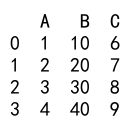
2. 向apply传递位置参数
在使用apply时,可以通过args参数传递一个元组,这个元组包含了传递给函数func的位置参数。
示例代码2:传递单个位置参数
import pandas as pd
# 创建DataFrame
df = pd.DataFrame({
'A': [1, 2, 3],
'B': [4, 5, 6]
})
# 定义函数
def multiply(x, factor):
return x * factor
# 应用函数
df['A'] = df['A'].apply(multiply, args=(10,))
print(df)
Output:
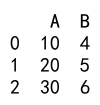
示例代码3:传递多个位置参数
import pandas as pd
# 创建DataFrame
df = pd.DataFrame({
'A': [1, 2, 3],
'B': [4, 5, 6]
})
# 定义函数
def operate(x, factor, increment):
return x * factor + increment
# 应用函数
df['A'] = df['A'].apply(operate, args=(10, 5))
print(df)
Output:
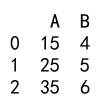
3. 向apply传递关键字参数
除了位置参数外,apply函数还允许传递关键字参数。这可以通过**kwds实现。
示例代码4:传递关键字参数
import pandas as pd
# 创建DataFrame
df = pd.DataFrame({
'A': [1, 2, 3],
'B': [4, 5, 6]
})
# 定义函数
def modify(x, factor=1, increment=0):
return x * factor + increment
# 应用函数
df['A'] = df['A'].apply(modify, factor=10, increment=5)
print(df)
Output:
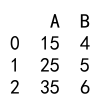
4. 使用apply处理DataFrame的行
apply函数不仅可以应用于Series,也可以应用于DataFrame的行或列。当处理DataFrame的行时,axis参数应设为1。
示例代码5:处理DataFrame的行
import pandas as pd
# 创建DataFrame
df = pd.DataFrame({
'A': [1, 2, 3],
'B': [4, 5, 6]
})
# 定义函数
def sum_row(row):
return row['A'] + row['B']
# 应用函数
df['Sum'] = df.apply(sum_row, axis=1)
print(df)
Output:
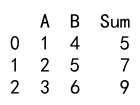
5. 使用lambda函数
在pandas的apply中使用lambda函数可以使代码更加简洁。Lambda函数是一种简单的可以在代码中快速定义的匿名函数。
示例代码6:使用lambda函数
import pandas as pd
# 创建DataFrame
df = pd.DataFrame({
'A': [1, 2, 3],
'B': [4, 5, 6]
})
# 使用lambda函数
df['A'] = df['A'].apply(lambda x: x * 10)
print(df)
Output:
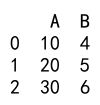
示例代码7:lambda函数与额外参数
import pandas as pd
# 创建DataFrame
df = pd.DataFrame({
'A': [1, 2, 3],
'B': [4, 5, 6]
})
# 使用lambda函数和额外参数
df['A'] = df['A'].apply(lambda x, factor: x * factor, args=(10,))
print(df)
Output:
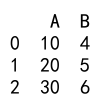
6. 复杂的函数应用
在实际的数据处理中,我们可能需要应用更复杂的函数,这些函数可能涉及多个参数和更复杂的逻辑。
示例代码8:更复杂的函数应用
import pandas as pd
# 创建DataFrame
df = pd.DataFrame({
'A': [10, 20, 30],
'B': [40, 50, 60]
})
# 定义复杂函数
def complex_operation(x, threshold, factor, increment):
if x > threshold:
return x * factor
else:
return x + increment
# 应用函数
df['A'] = df['A'].apply(complex_operation, args=(15, 2, 5))
print(df)
Output:
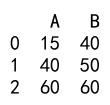
7. 结合条件语句
在使用apply函数时,可以结合条件语句来进行更加灵活的数据处理。
示例代码9:结合条件语句
import pandas as pd
# 创建DataFrame
df = pd.DataFrame({
'A': [10, 20, 30],
'B': [40, 50, 60]
})
# 定义函数
def check_and_operate(x, check_value, factor, increment):
if x > check_value:
return x * factor
return x + increment
# 应用函数
df['A'] = df['A'].apply(check_and_operate, args=(25, 2, 10))
print(df)
Output:
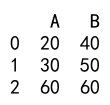
8. 处理多列数据
在某些情况下,我们需要在apply函数中处理多列数据。这可以通过在函数中访问不同的列来实现。
示例代码10:处理多列数据
import pandas as pd
# 创建DataFrame
df = pd.DataFrame({
'A': [1, 2, 3],
'B': [4, 5, 6],
'C': [7, 8, 9]
})
# 定义函数
def process_multiple_columns(row):
return row['A'] * row['B'] + row['C']
# 应用函数
df['D'] = df.apply(process_multiple_columns, axis=1)
print(df)
Output:
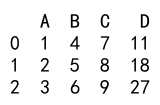
示例代码11:使用关键字参数和lambda函数
import pandas as pd
# 创建DataFrame
df = pd.DataFrame({
'A': [10, 20, 30],
'B': [40, 50, 60]
})
# 使用lambda函数和关键字参数
df['A'] = df['A'].apply(lambda x, increment: x + increment, increment=100)
print(df)
Output:
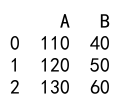
示例代码12:使用apply函数进行数据标准化
import pandas as pd
# 创建DataFrame
df = pd.DataFrame({
'A': [1, 2, 3],
'B': [4, 5, 6]
})
# 定义标准化函数
def standardize(x):
return (x - x.mean()) / x.std()
# 应用函数
df_standardized = df.apply(standardize)
print(df_standardized)
Output:
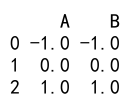
示例代码13:使用apply和args处理时间数据
import pandas as pd
# 创建DataFrame
df = pd.DataFrame({
'Date': ['2021-01-01', '2021-01-02', '2021-01-03']
})
# 定义函数解析日期
def parse_date(date, format):
return pd.to_datetime(date, format=format)
# 应用函数
df['Date'] = df['Date'].apply(parse_date, format='%Y-%m-%d')
print(df)
Output:
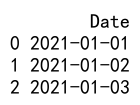
示例代码14:使用apply进行更复杂的数据转换
import pandas as pd
# 创建DataFrame
df = pd.DataFrame({
'A': [10, 20, 30],
'B': [40, 50, 60],
'C': [70, 80, 90]
})
# 定义复杂的转换函数
def complex_transform(row):
return row['A'] * row['B'] - row['C']
# 应用函数
df['D'] = df.apply(complex_transform, axis=1)
print(df)
Output:
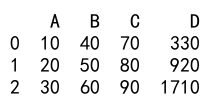
示例代码15:结合条件语句和lambda函数
import pandas as pd
# 创建DataFrame
df = pd.DataFrame({
'A': [10, 20, 30],
'B': [40, 50, 60]
})
# 使用lambda函数和条件语句
df['A'] = df['A'].apply(lambda x: x * 2 if x > 15 else x + 5)
print(df)
Output:
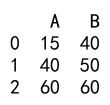
示例代码16:apply函数与复杂逻辑结合
import pandas as pd
# 创建DataFrame
df = pd.DataFrame({
'A': [10, 20, 30],
'B': [40, 50, 60],
'C': [70, 80, 90]
})
# 定义复杂逻辑函数
def complex_logic(row):
if row['A'] > 15 and row['B'] < 55:
return row['C'] * 2
else:
return row['C'] + 10
# 应用函数
df['D'] = df.apply(complex_logic, axis=1)
print(df)
Output:
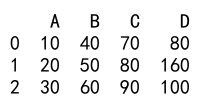
示例代码17:使用apply进行异常值检测
import pandas as pd
# 创建DataFrame
df = pd.DataFrame({
'A': [1, 2, 300, 4, 5],
'B': [6, 7, 8, 900, 10]
})
# 定义异常值检测函数
def detect_outliers(x):
threshold = x.mean() + 2 * x.std()
return x > threshold
# 应用函数
outliers = df.apply(detect_outliers)
print(outliers)
Output:

示例代码18:apply函数与数据聚合
import pandas as pd
# 创建DataFrame
df = pd.DataFrame({
'A': [1, 2, 3, 4, 5],
'B': [5, 4, 3, 2, 1]
})
# 定义数据聚合函数
def aggregate_data(x):
return sum(x)
# 应用函数
total = df.apply(aggregate_data)
print(total)
Output:

示例代码19:使用apply进行数据分组和转换
import pandas as pd
# 创建DataFrame
df = pd.DataFrame({
'A': [1, 2, 3, 4, 5],
'B': [10, 20, 30, 40, 50],
'Group': ['X', 'Y', 'X', 'Y', 'X']
})
# 定义分组转换函数
def transform_by_group(data):
return data - data.mean()
# 应用函数
df['B'] = df.groupby('Group')['B'].transform(transform_by_group)
print(df)
Output:
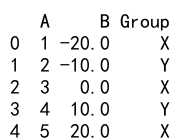
示例代码20:结合apply和自定义函数进行数据清洗
import pandas as pd
# 创建DataFrame
df = pd.DataFrame({
'Text': ['example@pandasdataframe.com', 'test@pandasdataframe.com', 'hello@pandasdataframe.com']
})
# 定义数据清洗函数
def clean_email(text):
return text.lower().replace('@pandasdataframe.com', '')
# 应用函数
df['Cleaned_Text'] = df['Text'].apply(clean_email)
print(df)
Output:

以上示例展示了如何在不同的数据处理场景中使用pandas的apply函数,包括基本的数据操作、条件逻辑处理、复杂的数据转换和清洗等。通过这些示例,可以看到apply函数的灵活性和强大功能,它是pandas库中不可或缺的工具之一。
 极客教程
极客教程